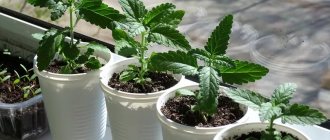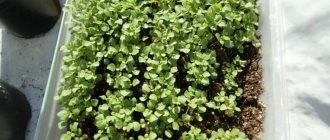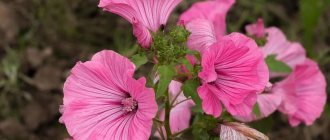Ornamental purslane is a colorful ground cover plant and is ideal for summer residents and gardeners who love unpretentious, low-maintenance, drought-resistant flowers. The plant is also suitable for growing in poor soils. The best way to get a plant on your site is to grow it from seeds at home. Thanks to seedlings, you can see earlier flowering.
Description and types of purslane, popular varieties
Purslane is a succulent plant, a herbaceous annual. It is widespread in the southern regions, where there is a warm climate. The plant forms a branched bush with a recumbent smooth stem of a reddish hue, up to 30 cm long. Leaves without cuttings, fleshy, ovate, look like spatulas.
The flowers of garden purslane are small (2-3 cm in diameter), simple, yellow in color. Decorative varieties have large flowers (up to 10 cm in diameter), bright, cup-shaped. The color of the petals can be white, red, pink, peach, orange. The buds bloom in June, flowering lasts until the end of summer. The seeds are collected in the fruit - a spherical box.
Purslane grandiflora is an attractive ornamental plant that decorates the flower garden until the first frost.
Purslane is divided into several types:
- Ampelous is a perennial hybrid species that is grown in open ground. The flowers are simple and come in various shades of red, white, purple and yellow. Flower growers plant ampelous purslane in hanging baskets and tall flowerpots so that the shoots hang beautifully.
- Garden purslane is an edible plant. It has beneficial and medicinal properties. The flowers of the plant are yellow and small in shape. The leaves are oval shaped and succulent.
Young leaves of garden purslane are used as food. They are put in salads, stews, seasonings, and pickled for the winter. In folk medicine, the plant is used externally as a wound-healing and anti-inflammatory agent. A decoction of seeds or leaves is taken internally to lower blood sugar levels, increase blood pressure and increase heart rate.
Purslane - food, healer, hormone of happiness and joy: video
- Large-flowered is a very popular species with a variety of flower colors. They decorate garden beds and are used to decorate summer cottages. In Russia, large-flowered purslane is grown as an annual plant.
- Terry is a variety of large-flowered purslane. The plant is low-growing with double flowers. Its most popular varieties are Splendence and White-flowered.
Popular varieties
Variety Splendex
- Red or scarlet purslane is one of the shortest among the representatives of the genus. The height of the branched bush is 12 cm. It is covered with small leaves and bright scarlet flowers, up to 5 cm in diameter. Flowering lasts until the first cold weather. The buds open only on a clear, sunny day.
- White purslane is attractive with large double flowers. The petals in the bud are snow-white, the core of the flower is bright yellow. The variety is characterized by rapid growth, reaching a diameter of 40 cm. The plant is resistant to heat and can grow on poor, rocky soil.
- Pun . A variety that includes plants with flowers of different colors and shapes (simple and double). The bush is creeping and can be planted as a ground cover.
- Sanglo. Purslane variety, with flowers up to 6 cm in diameter. They are densely terry, open even in cloudy weather. Colors: white, pink, yellow, red, salmon.
- The Splendex variety is characterized by purple-pink flowers, up to 4 cm in diameter. The height of the bushes is 10-12 cm.
- Flamenco. Purslane, 20 cm high and flowers of white, yellow, scarlet, pink color. The plant does not tolerate clay and damp soils and withstands drought well.
Variety Flamenco
The common feature for most varieties of purslane is prolonged flowering, until the arrival of frost, which will kill the plant. If you plant bushes in containers, you can prolong the bright flowering by placing the purslane in a warm place in the fall and providing lighting.
Cultural information
In nature, there are up to 200 varieties of purslane. The most famous type of purslane is the grandiflora (portulaca grandiflora).
The height of the bushes is 10-25 centimeters. The plant is distinguished by succulent, fleshy leaves and shoots. In June, buds appear in white, yellow, pink, red, and orange colors. Flowering lasts all summer. In autumn, seed pods appear.
Purslane can reproduce by self-sowing. At the same time, the parental features of the culture are not always preserved. If this season the petals were terry, then next year the waviness may disappear.
The culture spreads across the ground, filling the space around it, which is why the plant is popularly called a rug. Another name for the plant is dandura.
When to sow purslane for seedlings
To admire purslane flowers already in June, you need to start sowing seeds already in March - April. The exact sowing time depends on the climate of the region where the site is located. Purslane does not tolerate sub-zero temperatures; seedlings are planted when warm weather sets in. The optimal age of purslane seedlings ready for planting in a flowerbed is about 8 weeks.
Based on these data, approximate dates for sowing purslane are obtained, depending on the region of residence:
- in the middle zone and Moscow region, seeds are sown from March 15 to April 10;
- in the Urals and Siberia in April;
- in the southern regions you can start sowing at the end of February - early March.
Keeping a weather calendar will help determine the optimal sowing time in a particular area. Records about the date of the last spring frost, the average daily temperature, made over several years, will help you choose the right time for planting.
Many gardeners and flower growers use tips from the Lunar calendar. It is believed that depending on the phase of the moon, certain parts of the plant (aerial or roots) grow intensively. There are favorable dates for sowing various crops and days prohibited for agricultural work. For example, on the days of the Full Moon and New Moon you cannot plant or prune plants.
Useful properties of Portulaca oleracea
Purslane - garden flowers, how they bloom and how they grow
Hippocrates, Arab and Indian healers, and the ancient Egyptians knew about what purslane is, what benefits it brings, and recipes from it. Purslane was once valued for its magical and healing properties. Garlands were woven from the grass to protect against evil spirits; it was used to treat scurvy, hemoptysis, kidneys, liver, and to cleanse the body of venereal diseases.
Important! Modern research confirms the ability of purslane to help with diseases associated with a lack of vitamins and microelements.
The composition of the herb includes carbohydrates, alkaloids, minerals, organic acids, vitamins of groups C, B, PP, K. The sourish taste of the plant is due to the presence of malic and oxalic acid in the tissues. Modern healers use it to heal wounds, treat diabetes, burns, as an antipyretic, anti-inflammatory, and diuretic.
Vegetable purslane and medicines made from it, consumed in excess, can cause harm to pregnant and lactating women. There are contraindications for taking medications that contain purslane components; they should not be used by hypertensive patients, patients with heart rhythm disorders, or those with allergies to the plant.
Use in cooking
The low calorie content (up to 20 kcal per 100 g) of raw purslane leaves and stems has made them a sought-after ingredient for use in fasting diets. Not only tender young plants are used for food. Coarsened old shoots are pickled, stewed, soups are cooked with them, casseroles are made, and salads are prepared.
Medicinal tincture of purslane shoots
How to grow purslane from seeds at home
Growing purslane from seeds is no more difficult than any other annual. The gardener needs to acquire soil, seedling containers, seeds and lamps for illumination if the seedlings are prepared before April.
Soil selection
Loose, light and infertile soil with a significant admixture of sand is suitable for the crop. At a flower shop you can purchase a ready-made substrate for succulents or “Universal” seedling soil. Purslane can be sown in the soil for cacti immediately, and the “universal” soil can be diluted with vermiculite or coarse sand, adding it in an amount of 25-30% of the total soil mass.
You can prepare soil for the plant yourself, using a mixture of peat, sand (vermiculite) and turf soil. All components are taken in equal shares. Humus and fertilizers are not added to the soil. It will be useful to add pieces of charcoal to the finished soil in a proportion of 20% of the total volume of the substrate.
Attention! Purslane is sensitive to fungal infections. To protect the plant from infection, the seedling soil must be disinfected: watered with a solution of potassium permanganate or Fitosporin.
Seed preparation
Purslane seeds are very small, comparable in size to petunia or poppy seeds. When properly stored (cool and dry), they remain viable for up to 3 years. When buying seeds in a store, you need to pay attention to the expiration date of the seeds and take the freshest ones.
To increase the germination percentage, some gardeners soak the seeds in the growth stimulator Epin or Zircon. In order not to lose the tiny seeds, they are immersed in the drug solution, scattered between two cotton pads, and tied with a thread.
Instead of ready-made drugs, you can use a natural stimulant - aloe juice. A few drops of juice, squeezed from a leaf that has been in the refrigerator for about 10 days, are dissolved in a glass of warm water.
Sowing methods
Purslane is sown in wide and shallow bowls (5-6 cm high). You can sow directly into separate cups, choosing wide and not tall ones, or into peat pots. It is convenient to sow flowers in seedling cassettes, where the plants develop in individual cells.
The container in which the seedlings will be located must have drainage holes. Stagnation of moisture in the soil has a detrimental effect on the root system of the succulent. In order to arrange additional drainage, it is useful to pour a little fine gravel or expanded clay onto the bottom of the container.
Landing step by step.
- Seedling containers filled with soil are well moistened.
- Seeds are scattered onto the damp surface of the soil, being careful not to sprinkle them too thickly.
Important! Due to their small size, the seeds cannot be covered with soil!
- The bowls with the crops are covered with a piece of glass or plastic wrap. Place the boxes in a warm place (temperature at least +25 degrees). In order for purslane seedlings to be friendly, the seeds must be exposed to sunlight. Until the sprouts appear, it is necessary to open the containers every day and ventilate the plantings. If necessary, moisten the top layer of soil with a spray bottle.
Some experienced flower growers practice sowing small seeds in the snow. A layer of snow 1 cm thick is placed on the surface of the soil and seeds are scattered on it.
This technique solves two problems at once: the density of seed distribution is clearly visible on a white background, and melt water has a beneficial effect on germination activity. There is no need to be afraid that the seeds will freeze; the snow layer will melt in the warmth in a couple of hours and will not cause harm to the plant.
We sow terry purslane. Sowing large-flowered purslane for seedlings - video
Seedling care
The first purslane sprouts may appear on the surface within three days after sowing, the rest will appear within a week. As soon as the sprouts appear on the surface, the film or glass is removed, providing the seedlings with maximum light.
Purslane seedlings are kept on the brightest windowsill - south or southeast. It is useful to supplement the plants with fluorescent lamps or special phyto lamps, extending daylight hours to 10-12 hours. Lack of lighting leads to stretching of bushes and loss of decorativeness.
Comfortable temperature in the room where purslane grows is +18 +20 degrees.
Watering the seedlings is carried out using a syringe or syringe, moistening the soil moderately. When the purslane grows, it is convenient to water the seedlings through a tray. The exception is plants planted in peat pots. They can only be watered from above, otherwise the bottom and walls of the pot will get wet and tear.
Important! You can’t overwater purslane! The next moistening is carried out when the top layer of soil dries out.
For irrigation, use only soft, settled water at room temperature. You can use melt or rain moisture.
Purslane does not require fertilizing. To prevent the development of the “black leg” disease, the seedlings are watered a couple of times with a solution of Fitosporin M.
If the seedlings are sown densely and begin to stretch out, they need to be replanted. The procedure is carried out in the phase of appearance of 2-3 true leaves. Replant small plants carefully, using a toothpick, trying not to damage the roots. After picking, it is useful to water the purslane with a solution of root or Heteroauxin.
5.Cooking recipes
Fresh young leaves and tops of shoots are added to salads as a seasoning, salted or pickled, prepared for the winter. This appetizer is perfect for hot meat dishes, but should not be used in combination with potatoes and vegetable salads of cucumbers and tomatoes. The fresh leaves taste like sorrel or spinach.
↑ Up,
Pickled leaves for the winter . Young shoots and leaves are cut into pieces 5-6 cm long and washed thoroughly in running water. Prepare small jars with a volume of 0.5 - 1 liter - wash and sterilize. Prepare the marinade as for cucumbers - add 2 tablespoons of salt and 3 sugar, 2 tablespoons of 6% vinegar per liter of boiling water. The shoots and leaves are immersed in boiling water for a few seconds and the water is allowed to drain. Garlic cloves and bay leaves are placed at the bottom of the jars. Fill the jars with shoots and pour marinade, cover with lids and roll up.
Garnish of young purslane shoots . Shoots and leaves are cut, sorted and washed with running water. Heat a frying pan with vegetable oil on the stove and place the shoots in it. Garlic and onions are added to the side dish, a little vinegar, brought to readiness and served with meat.
↑ Up,
When and how to transplant purslane seedlings into open ground
The seedlings are moved to the flower garden when the threat of frost has passed and the weather has settled with a night temperature of at least +10 degrees. In the middle zone, suitable weather occurs in mid-to-late May. In regions with cold climates, purslane is planted in beds in June.
If the flower has already been planted, but cold weather is expected, small bushes are covered with cut plastic bottles or arches are installed and covering material is pulled on.
For purslane, choose well-lit areas. Only in bright sun will flowering be abundant and bright. It is ideal if the flowerbed is protected from the cold wind by buildings or plants.
The soil in the garden bed must be breathable, neutral or alkaline. To loosen it, add sand, fine gravel, and granite chips.
Attention! Do not add humus or compost to the ground. Excess fertilizer leads to active growth of greenery, but flowering will be poor.
Before planting purslane in the garden, the seedlings must be hardened off - accustomed to fresh air. To do this, 10-12 days before planting in the ground, the plants are taken outside “for a walk.” At first, the duration of sunbathing is an hour to an hour and a half, gradually increasing the time spent outside.
Planting purslane in open ground
- Purslane is planted at a distance of 10-20 cm from each other, compact varieties are placed closer to each other.
- The plant is transferred from the seedling container to the hole without collapsing the earthen ball. The bush is not buried; it is planted as it grew in the pot.
- After planting, purslane is watered abundantly.
The procedure for planting seedlings in open ground is best done in the evening or in cloudy weather. To facilitate the adaptation of plants in a new place, water them with Heteroauxin or spray the foliage with Epin.
Plant after flowering
Yellow purslane
Experienced gardeners recommend removing flowers from shoots immediately after they have bloomed and begun to fade. If you skip this moment and let the flowers dry completely, it will be difficult to see the fruit with seeds.
The box is torn off when it has already turned yellow, but is not yet quite ripe, so that it cracks already in the container or on the paper, and the seeds do not fall into the ground. It is almost impossible to collect the smallest seeds from the surface of the soil - it looks like dust: 50 thousand seeds fit into 1 teaspoon.
If the boxes cannot be collected on time, they can be tied up with gauze bags to prevent the seeds from scattering.
Purslane fruits ripen 2–4 weeks after pollination (the period depends on weather conditions). Freshly harvested seeds acquire germination only the next season, but retain this property for 3–4 years.
The plant does not overwinter in open ground , so after all the flowers and stems have dried, the flower garden can be completely cleared of the plant. Seeds that fall into the ground by self-sowing relieve the gardener from the need for targeted planting next spring.
Further care for purslane
The flower can rightfully be called an unpretentious plant. All he needs is light and warmth. Purslane tolerates drought well, but it needs moisture for lush flowering.
Watering
For purslane, it is enough to moisten the soil once a week. If there is precipitation, watering is postponed until the top layer of soil dries. Water at the root, without getting water on the flowers.
Use only warm water, preferably soft (rain, from a river, pond).
Weeding, loosening
While the purslane bushes are small, the flower garden is regularly weeded, and the soil is loosened after watering. Later, the plants grow and the bushes close together. The need for earthworks disappears.
If rainy weather sets in, it is necessary to loosen the soil around the bushes more often, drying it out. It is useful to arrange grooves around the flower bed to drain excess moisture.
Fertilizers for abundant flowering
Purslane is not fed with anything, since excess nutrients lead to green growth, to the detriment of flowering. To form large bright buds, purslane needs sun and warmth.
When and how to collect seeds
Purslane seeds have time to fully ripen in the short summer of the middle zone, and they can be used for further sowing. The seeds ripen in a seed pod, which is called a “little box” because of its resemblance to the vessel of the same name.
A signal of seed ripeness is the coloring of the seed pods brown or brown. They are collected from the plant and dried at home. The seeds are removed by breaking the capsules and pouring the seeds onto paper. Store purslane planting material in a dark, dry place, in a glass jar or paper bag.
Purslane in landscape design
Purslane, due to its compact size and drought resistance, is an ideal container plant. It is actively planted in balcony pots and flowerpots.
The plant looks appropriate in a rocky garden and on an alpine hill, in the foreground of mixed flower beds. Purslane is often planted to replace fading bulbous flowers.
What flowers are combined with in the flowerbed?
The low-growing bright purslane is beautiful in a monoflower. It is self-sufficient and does not require additions. It can be combined:
- with silvery cineraria;
- bright celosia;
- alyssum;
- petunia;
- dwarf roses;
- pansies;
- marigolds.











